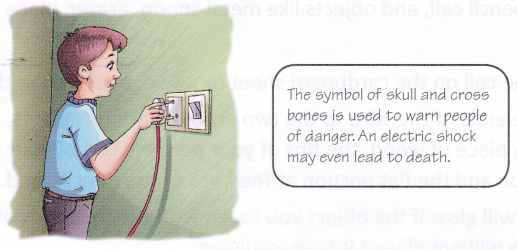Conductors and insulators
Look at Figures (a)-(d). Each shows a complete electric circuit. Then why is it that the bulb glows only in circuits (b) and (d)? It is because not all materials allow electric current to pass through them.

A material that allows electric current to pass through it is called a conductor of electricity like the key and the safety pin [Figs. (b) and (d)]. A material that does not allow electric current to pass through it is called an insulator of electricity like the rubber band and the plastic pen [Figs.(a) and (c)].
All metals are conductors of electricity while some are better conductors than others. A few non-metals like graphite (pencil lead is made of graphite) are also conductors of electricity.
Examples of insulators are glass, wood, rubber, pure water, and dry air. However, the smallest impurity in water (impurities are substances like salts, dissolved in water) makes it a conductor.
The handles of screwdrivers and testers used by electricians are usually made of wood or hard plastic. They also wear rubber gloves while repairing an electric switch to avoid electric shock.
Activity
Aim: To identify conductors and insulators from a given set of materials (adult supervision required)
Materials needed: Three pieces of wire, about 8-10 inches each (from your local electrical shop), a small torch bulb, a thick sheet of cardboard or wood (about 4 inches x 4 inches), sticky tape, pencil cell, and objects like metal spoon, eraser, piece of wood, etc.
Method:
1. Fix the bulb and the cell on the cardboard sheet or wood, as shown in the figure.
2. Touch the two free ends of the wire to the two ends of various objects, like a metal spoon, an eraser, a piece of wood, the tips of your pen, the tips of your pencil lead (the pointed portion and the flat portion at the back of the pencil), and so on.
 Observation The bulb will glow if the object you touch with the free ends of the wire is a conductor, and the bulb will not glow if it is an insulator.
Observation The bulb will glow if the object you touch with the free ends of the wire is a conductor, and the bulb will not glow if it is an insulator.
Conclusion This way you will be able to classify various materials as conductors and insulators.
Electrical safety
Electricity can be very dangerous, if you do not handle electrical devices carefully. One should never play with electrical wires and sockets. Electricity from cells is safe and you can experiment with it, but you have to be careful not to connect the two terminals of a cell directly through a wire/conductor. Electricity generated by portable generators is dangerous and should not be used for experiments.
Do not plug in or take out the cords of any electrical appliances with wet hands. This can give you an electrical shock.
